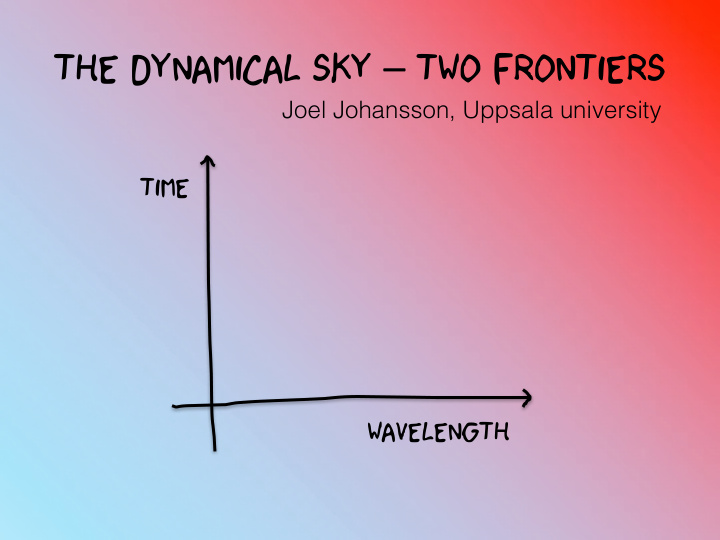



The dynamical sky – Two frontiers Joel Johansson, Uppsala university Time Wavelength
Optical surveys – faster! HSC, 1.7 deg 2 PS1, 7 deg 2 DES, 2.5 deg 2 PTF/iPTF, 7.3 deg 2 ZTF, 47 deg 2 LSST, 9.6 deg 2 1 deg
Optical “ phase-space ” of Transients
The dynamical sky – GO FASTER! • Fast transients (e.g. orphan GRBs, Cenko+15 ) • Probe very final stages of stars lives! – Companion star in Type Ia supernovae? (e.g. Kasen 2010 ) – Shock break-out in core-collapse SNe (e.g. Rubin+2015 ) – “Flash”-ionization of circumstellar material (e.g. Gal-Yam+2014) 15 -18 iPTF13dqy ( Yaron+17) 16 -17 17 First detection Apparent AB Magnitude 16 -16 Absolute Magnitude ~3 hours after 18 17 NOT NOT FTS -15 explosion ! ALFOSC FLOYDS ALFOSC 18 19 19 -14 20 Keck1 20 First spectrum 3 hours LRIS P200 21 -13 DBSP after detection… 21 22 0 10 20 30 40 50 -12 Hours from explosion PTF R-band 22 3 σ limits Polynomial Fit -11 23 0 5 10 15 20 25 30 35 Days from explosion (MJD - 56571.12)
Rapid (“ Flash ”) spectroscopy (iPTF13dqy, Yaron+17 ) He II O VI 10 -15 O V Scaled F λ + shift (erg cm -2 s -1 Ang -1 ) 10 -16 O IV KeckI +6.2 hr Dense CSM +7.2 hr within ~10 15 cm +8.9 hr N V +10.1 hr 10 -17 NOT +21.1 hr Ejected during FTS +1.4 d the final year at high rate NOT +1.9 d 10 -18 (~10 -3 M ¤ /yr) P200 +2.0 d KeckII +2.1 d KeckII +5.1 d FTS +5.3 d H 10 -19 3500 4000 4500 5000 5500 6000 6500 7000 7500 8000 8500 Rest Wavelength (Angstrom)
Rapid (“ Flash ”) spectroscopy (Johansson in prep.) C III? N IV ? Sample of ~20 PTF SNe (+ few objects from literature) with flash- spectroscopy PTF has total of ~700 Type II supernovae. Still, not rare! ~14% of SNe II should show flash-features ( Khazov+15 )
The dynamical sky – Two frontiers Time Wavelength
The dynamical sky – GO REDDER! The Spitzer InfraRed Intensive Transients Survey (SPIRITS) - 0.85 metre mirror - 5.2´ × 5.2´ FOV - IRAC, post-cryo: 3.6 and 4.5 µm - 190 nearby galaxies (< 20 Mpc )
The dynamical sky – GO REDDER! NGC 2403 (Credit: Howard Bond)
Mid-IR ” Phase-space ” of Transients ~150 transients: -20 40 supernovae Type IIb (SN2011dh) Supernovae 20 novae 3.6um Mid-IR Luminosity (Abs Mag) 60 “mysteries” Type Ia (SN2014J) -15 Intermediate Luminosity Red Transients dust-dominated (V1668 Cyg) -10 Novae metal-dominated (QU Vul) -5 10 100 1000 Time (Days)
Mid-IR ” Phase-space ” of Transients ~150 transients: 40 supernovae 20 novae 60 “mysteries” >1200 variables Extreme? -10.0 Absolute Magnitude (3.6um) -9.5 RSG -9.0 O-AGB -8.5 C-AGB -8.0 100 200 300 400 500 600 Days
Mid-IR ” Phase-space ” of Transients Kasliwal et al. (in prep.) ~150 transients: -20 40 supernovae Type IIb (SN2011dh) Supernovae 20 novae 3.6um Mid-IR Luminosity (Abs Mag) 60 “mysteries” Type Ia (SN2014J) -15 Intermediate Luminosity Red Transients 14aje 14ajc 14axa 14aei dust-dominated (V1668 Cyg) Mysteries = “SPRITES” -10 No optical/NIR counterparts! Novae (Kasliwal+2017) Massive binaries driving shocks metal-dominated (QU Vul) in molecular clous? Stellar mergers with dusty winds? -5 Enshrouded SNe? 10 100 1000 Time (Days)
Mid-IR ” Phase-space ” of SUPERNOVAE Type IIn/Ia-CSM SNe e.g. Fox&Filippenko (2013) Type IIn/Ia-CSM Core-collapse SNe Core-collapse SNe Sample in Tinyanont+16 SN 2011dh ( Helou+13 ) SN 2013ej ( Mauerhan+17 ) SN 2014C ( Tinyanont et al. ) SN 2014bi ( Johansson et al. ) Type Ia SNe Type Ia SNe Sample in Johansson+17 SN 2014J ”Impostors” ”SN Impostors” SNHunt248 ( Mauerhan+17 )
The IR surprise from SN 2014dt - Peculiar, subluminous ”SN Iax” - Nearby (M61 @ 12 Mpc) Type IIn/Ia-CSM - Bright in the mid-IR! - Late time IR-rise Core-collapse SNe (>2 mags @ 4.5 μ m)! SN 2014dt Type Ia SNe ”Impostors”
The IR surprise from SN 2014dt 20” Keck/LRIS, I-band, 5x240 sec. ;c9bf5d (2017-01-02) 20” Mid-IR excess from warm dust? - No progenitor in archival HST-images - M dust ≈ 10 -5 M ¤ at T dust ≈ 700 K - No signs of reddening/Na ID absorption… - Pre-existing or newly formed? ( Foley et al. 2014, 2016 ) ( Fox, Johansson et al., 2016 )
The IR surprise from SN 2014dt Progenitor system in HST images. SN 2014dt Luminous/blue Helium star, SN 2012Z donor to accreting White Dwarf (McCully+14) Thermonuclear ”deflagration” of a WD that doesn’t completely unbind the star. (Kromer+13,15)
The IR surprise from SN 2014dt 1. Circumstellar dust? (no reddening / Na ID absorption…) 2. ”IR-catastrophe”? (Fransson&Jerkstrand 2015) 3. Bound remnant? Optically thick wind blown from partially disrupted progenitor WD?
SUMMARY • Pushing the time frontier allow us to find SNe as they happen (ZTF now on sky!) • UV follow-up and flash-spectroscopy probes mass loss during the final year of stars lives (more robotic spectrographs coming up…) • SPIRITS survey finding lots of previously missed transients! • IR probes mass loss histories thousands of years prior to SN explosions
Recommend
More recommend